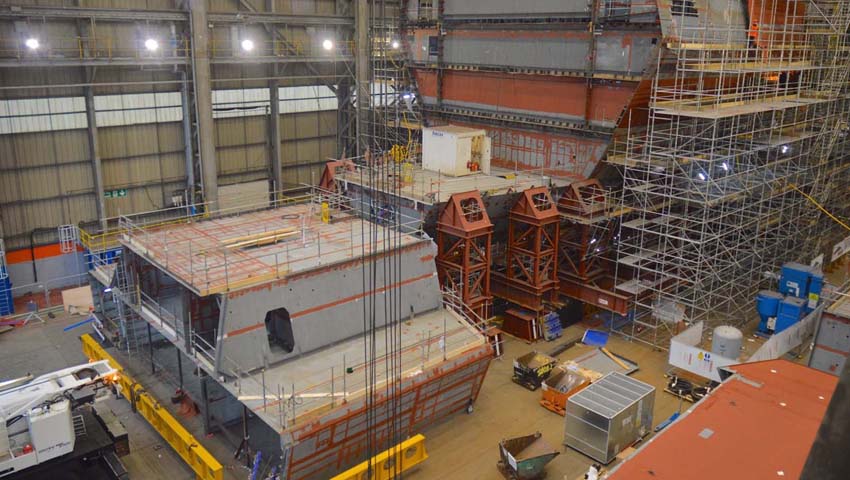BAE Systems he kick started the next-stage of construction for the Royal Navy’s first Type 26-based City Class future frigate, HMS Glasgow, at the company’s shipyard, with a round of new supply contracts recently signed to support the fleet build.
Construction has begun on the 57th segment of the 8,000-tonne jigsaw which is HMS Glasgow, the first of eight Type 26 warships. It’s almost two years to the day that work on Glasgow began in the yard on the Clyde, with many of the completed sections pieced together in one of BAE’s assembly halls.
Work began on this last section of ship as another £100 million (AU$180 million) of contracts were placed with the vast supply chain needed to build the world’s most advanced submarine hunter.
Firms in Glasgow, Hartlepool, Nottingham and Dorset will provide a range of services and assistance with the construction of the class, including painting, cabling and insulation – work all essential to the outfitting of the ships – and the eventual float off when a barge lowers the frigates in the Clyde.
The new contracts will support 250 jobs, with the Type 26 program sustaining more than 4,000 jobs in total across the UK, helping to support the nation’s economic recovery by maintaining much-needed skills and capabilities.
More than £1 billion ($1.8 billion) has been invested across the program’s supply chain to date, with more than 100 suppliers globally.
UK Defence Secretary Ben Wallace said, "The Type 26 program has proven itself in terms of cutting-edge design, international defence exports and creating and sustaining British jobs. This latest round of contract awards will see companies from the south coast of England to the banks of the Clyde benefit from over 250 highly-skilled jobs and multimillion-pound investment."
Designed and built by BAE Systems in Glasgow, the Type 26 frigate is an advanced anti-submarine warship, which will deliver critical protection of the Royal Navy’s Continuous At Sea Deterrent and Carrier Strike Group.
BAE Systems Naval Ships managing director Steve Timms expanded on Secretary Wallace's statements, saying, "Each of our new suppliers brings a unique capability that is essential to ensure the safe and continued progress of this nationally important program. It’s fantastic to see the first of class, HMS Glasgow, taking shape at our facilities here on the Clyde."
The Type 26 builds on the pedigree of the RN’s current Type 23 anti-submarine warfare frigates which continue to serve the UK.
"She is a source of great pride for our workforce who have worked with real energy, commitment and innovation in recent months to ensure we meet our customer commitments," Timms added.
Armed with the Sea Ceptor missile defence system, a new five-inch main gun, a flexible mission bay, Artisan 997 Medium Range Radar, powerful bow and towed array sonars and with a Merlin or Wildcat helicopter embarked, the 26s will shield the Navy’s carrier strike groups from hostile submarines.
In addition five Type 31 general purpose frigates are intended to replace the general-duty Type 23s currently in service and also coming towards the end of their long and useful careers.
Each Type 26 will be equipped with a range of world-class capabilities including the Sea Ceptor missile defence system, a five-inch medium calibre gun, flexible mission bay, Artisan 997 Medium Range Radar, powerful bow and towed array sonars.
The Type 26 is the original variant of BAE Systems’ Global Combat Ship, which supports a close partnership between the RN, Royal Canadian Navy and the Royal Australian Navy.
Australia and Canada both selected a variant of the Type 26 design for their anti-submarine frigate programs, supporting greater operational, training and intelligence ties between the three nations.
In June 2018, the Commonwealth government announced BAE Systems Australia as the successful tender for the $35 billion SEA 5000 Future Frigate program.
The nine Hunter Class frigates will replace the eight Anzac class frigates when they enter service beginning in the late 2020s.
The Hunter Class is billed as an anti-submarine warfare (ASW) centric vessel delivering an advanced ASW capability to the RAN at a time when 50 per cent of the world’s submarines will be operating in the Indo-Pacific region.
BAE Systems Australia announced that it had selected Lockheed Martin Australia and Saab Australia as combat systems integration industry partners, responsible for delivering the Australian designed CEAFAR 2 Active Phased Array Radar, Lockheed Martin designed Aegis combat management system and Saab Australia 9LV tactical interface.
Aegis is capable of simultaneously defending against attack from land targets, submarines and surface ships while automatically protecting the fleet against aircraft, cruise missiles and ballistic missiles.
The $35 billion program sees ASC Shipbuilding become a subsidiary of BAE Systems throughout the build process beginning in 2020 at the Osborne Shipyard in South Australia, creating more than 4,000 jobs.
BAE Systems expects the Australian industry content (AIC) for the Hunter Class build will be 65-70 per cent, which will create and secure thousands of jobs for decades.
At the end of the program the Commonwealth will resume complete ownership of ASC Shipbuilding, thereby ensuring the retention in Australia of intellectual property, a highly skilled workforce and the associated equipment.
SEA 5000 is expected to support over 500 Australian businesses who have been pre-qualified to be part of the Hunter Class supply chain, with the Australian steel industry in particular, benefiting from the 48,000 tonnes of steel required to build the ships.






